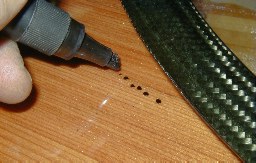 |
It is not unusual
to get a varnish sag or drip in every coat you put on (only practice
and knowledge of varnish behavior will improve it).
The quickly drying varnish leaves only a short window of opportunity
to go back and touch things up. If you don't catch these sags within
45 seconds or so, don't even attempt to go back and fix it. The fresh
varnish will refuse to feather and blend seamlessly into the 'older'
coat and more sags are sure to follow. Instead, wait until the next
day and before you start to wet-sand for the next coat, highlight
the high spots of the sags with a magic marker so that you can see them
when you sand. Unmarked drips are completely invisible under a sheet
of water. When the magic marker disappears, you know that the drip has
been safely sanded out (spend some more time on the spot just to make
sure).
|

